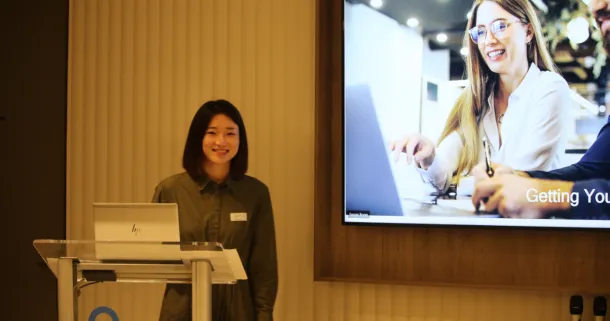Actuarial careers
Industry topics

Claim your CPD points
In today’s world of hybrid meetings and global teams, the ability to stand out – whether in a Zoom call or a boardroom - is more important than ever.
At the recent Young Actuaries Program (YAP) Career Series session “Getting Your Voice Heard,” experienced actuarial leaders Ryan Boyd (Finance Director, Allianz Partners) and Jessica Chen (GM Financial Performance, QBE) shared their hard-won tactics for ensuring your ideas don’t simply drift into the chat log.
Over 75 minutes, the session covered everything from setting up your camera to debriefing with a CFO, helping you ensure your next contribution makes an impact.
Before the session began, in-person attendees and watch party guests enjoyed pizza, catching up with old friends and meeting some new faces, which set a relaxed, welcoming tone for the engaging discussions that followed.
Laura Zhao (Senior Underwriter, Freely) expertly chaired the session, which centred on two case studies prepared by Julia Lessing (Director, Guardian Actuarial) to spark discussion among new and aspiring actuaries. With participants ranging from recent graduates to professionals with nearly a decade of experience, and representing practice areas from regulators to reinsurers, the room was rich with diverse perspectives.
Each contributor added their own point of view, taking the conversation well beyond the slides—a big reason to join these sessions live.

Session attendees discussing the case studies from the session.
Ryan kicked off with a deceptively simple reminder - if you want presence, turn your camera on.
Despite being in a different location (and possibly in your less ‘curated’ WFH attire), “it definitely shows the audience that you are trying to connect with them.”
He also recommends creating a conversation-sparking background or objects like his Lego Colosseum, so you break the ice before you’ve said a word. Likewise, sharing your screen early signals you’re ready to lead and gives you a foothold on the room’s big screen.
A surefire way to avoid getting buried in the agenda is to pre-align with the meeting chair:
Jessica added that these steps show respect for the chair’s agenda-setting role and primes the audience to give you space when you speak.
If slide decks and screen shares are your technical toolkit, one-on-ones are your relational secret weapon.
Both presenters emphasised the value of spending 10–15 minutes a day checking in with teammates — whether it’s through a quick Teams message, a WhatsApp note or even a GIF. These small moments of connection help build trust, which in turn gives you the confidence to speak up when it counts and makes others more likely to listen.
When it’s your moment to speak up, make the most of tools available:
And if your audio’s a bit laggy, give the group a heads-up – “My audio is delayed; please pause a beat before replying”—to keep the conversation flowing.
In rooms where assertive voices dominate, try:
Jessica’s useful tip? “It's OK to share a problem, but you have to follow up with a solution, or at least a few options... and that's what actually makes senior people notice you”.
Case study two highlighted presenting a piece of analysis to a CFO who is becoming dismissive of the results. Ryan and Jessica recommended solutions for:
Ryan leaned on personal experience from the other side of the table, sharing, “I'm looking for a concise message that is 'What strategic value is this point gunning towards, and how does that help our organisation?' especially when I'm listening to actuaries.”
Senior leaders value candid dialogue. They are looking for problems that need solving and want to know how they can help.
In your next one-on-one, try:
These meetings are your chance to stand out as a problem-solver, not just a number-cruncher.
If you’re running the meeting, manage airtime by:
If someone repeatedly hogs the mic, a quick private chat after the meeting can reset expectations without causing embarrassment.”
When slides fail or audio cuts out, both experts prescribe the same remedy - “Sorry about that—let me do that again,” and then recover seamlessly. Remember, a pause feels longer to you than to anyone else. Make every word count.
Technical acumen sets the stage, but speaking up with clarity, confidence and strategic insight is what shapes decisions.
Whether you’re pitching a pricing change or flagging regulatory risk, the tools shared by Ryan and Jessica equip you to break through the noise. The question now is simple: which tactic will you try at your next meeting?
“Getting Your Voice Heard” was just one of many practical, career-focused events designed to support early-career actuaries. If you found these insights helpful — or want to hear more candid advice from leaders in the profession — keep an eye out for future YAP Career Series sessions by checking the Events Calendar or your inbox for updates.